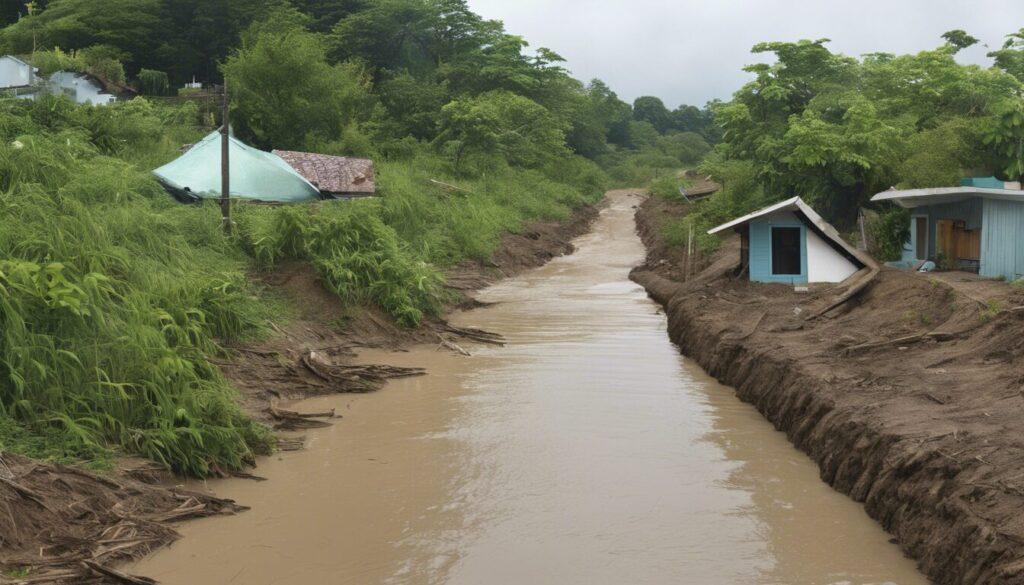What is climate adaptation? A Comprehensive Guide

What is climate adaptation? A Comprehensive Guide
Introduction: The Growing Need for Climate Adaptation
Climate change is not a distant concern—it’s a present-day actuality that communities and ecosystems worldwide should confront. With rising international temperatures, sea ranges, and more and more unpredictable climate patterns, understanding tips on how to adapt is important for survival. The process of changing our political, social, and economic structures to mitigate the effects of climate change and take advantage of its potential future benefits is known as climate adaptation.
What is climate adaptation? A Comprehensive GuideBut what does climate adaptation entail? How does it differ from mitigation or resilience? And, extra importantly, what methods can we implement to adapt efficiently? In this information, we’ll discover these questions in depth, offering a complete overview for novices and consultants.

1. What is Climate Adaptation?
Climate adaptation refers to the actions taken to scale back the detrimental impacts of climate change while maximizing potential advantages. Unlike mitigation, which aims to scale back or stop the emission of greenhouse gases, adaptation is about adjusting to the present and anticipated future impacts of climate change. It’s an ongoing technique of studying and enhancing as circumstances change.
Key Components of Climate Adaptation
- Reactive adaptation deals with the effects of the climate after they happen, whereas proactive adaptation prepares for future occurrences, such as elevating buildings in flood-prone areas.
- Hard vs. Soft Adaptation Measures: Hard adaptation contains bodily infrastructure adjustments (e.g., constructing sea partitions), whereas tender adaptation entails adjustments in insurance policies or behaviors (e.g., selling water conservation).
2. Climate Adaptation vs. Climate Resilience
Climate adaptation and resilience are sometimes used interchangeably, but they differ barely. While adaptation focuses on adjusting to adjustments, resilience is regarded as the capability of programs to soak up shocks and preserve operation. A resilient system can be better from climate impacts extra rapidly and with much less harm.
Differences:
- Adaptation: Adjusts to new climate circumstances.
- Resilience: Focuses on a system’s means to better after climate-related shocks.
Both adaptation and resilience are important methods in managing climate dangers. Communities and companies should incorporate each to safeguard against future climate impacts.
3. Climate Adaptation Strategies
To successfully adapt to climate change, societies should undertake methods tailor-made to their particular vulnerabilities. These methods could be divided into many classes:
3.1 Infrastructure Adaptation
Modifying bodily buildings to face up to climate dangers is one of the vital direct types of adaptation. This contains:
- Sea partitions and levees to guard coastal areas from rising sea ranges.
- Climate-resilient buildings are designed to deal with excessive climate circumstances.
- Experienced zones are built into smart city plans to manage heat and reduce flooding.
3.2 Ecosystem-Based Adaptation
Natural programs play a significant function in helping communities adapt to climate change. Strategies embody:
- Restoring wetlands and mangroves may act as buffers in opposition to storm surges and rising sea ranges.
- Reforesting enhances water quality, cuts erosion, and mitigates the results of heat waves.
- Sustainable agricultural practices that enhance soil well-being and cut back vulnerability to droughts.
3.3 Community-Based Adaptation
Indigenous communities must be involved in the adaptation process to ensure that the solutions are tailored to the unique requirements and circumstances of the area.
- Community training applications that elevate consciousness about climate dangers.
- Participatory planning processes that contain native stakeholders in decision-making.
- Disaster preparedness coaching to scale back vulnerabilities and enhance response instances.

4. Climate Adaptation vs. Mitigation
While adaptation focuses on adjusting to climate change, mitigation goals sort out its root trigger—decreasing greenhouse fuel emissions. Though they operate on completely different timelines, both strategies are essential for long-term climate threat management.
- Mitigation works to decelerate the development of climate change by decreasing emissions.
- Adaptation addresses the fast and future impacts; societies can address climate adjustments already underway.
Example of Combined Strategies:
A coastal city could invest in adaptation strategies like building sea walls and developing early warning systems for extreme weather events in addition to mitigation strategies like switching to renewable energy sources.
5. Why is Climate Adaptation Important?
The importance of adaptation increases as the effects of the global climate become more apparent. Some key causes embody:
- Minimizing Economic Losses: Unchecked climate dangers can devastate native and international economies. Proactive adaptation reduces the financial burden of climate-related disasters.
- Keeping vulnerable populations safe: Communities already struggling with financial issues may be more vulnerable to the effects of climate change. Adaptation methods can enhance the resilience of those communities.
- Ensuring Long-Term Sustainability: Adaptation helps be sure that pure assets, similar to water and meals, stay obtainable regardless of altering circumstances.
6. Examples of Climate Adaptation in Action
6.1 Agriculture in Africa
In areas where drought is turning into extra frequent, farmers are adapting by utilizing drought-resistant crops and adopting progressive irrigation methods. These efforts not only assist meal safety but also construct resilience to future climate variability.
6.2 Flood Management within the Netherlands
The Netherlands has long been a leader in flood management because most of its territory is below sea level. Safety against rising sea levels and extreme weather events is guaranteed by the country’s extensive network of dikes, storm surge barriers, and water pumps.
7. How to Implement Climate Adaptation Strategies
7.1 Policy and Governance
Governments play a vital function in creating frameworks that encourage adaptation. This contains:
- Developing nationwide adaptation plans (NAPs).
- Implementing laws that guarantee new infrastructure meets climate resilience requirements.
- Private sector involvement in adaptation initiatives is encouraged.
7.2 Finance and Investment
Adequate funding is important for large-scale adaptation initiatives. This can come from quite a lot of sources:
- Government and international organizations provide public funds.
- Private sector investments in resilience-enhancing infrastructure.
- Insurance mechanisms that assist communities and companies get better from climate impacts.
8. Challenges to Climate Adaptation
Despite its significance, there are several obstacles to profitable climate adaptation, together with:
- Financial limitations, notably in creating nations.
- Lack of technical experience to implement efficient methods.
- Political and institutional inertia is the place where decision-makers prioritize short-term advantages over long-term adaptation planning.

9. Future of Climate Adaptation
As climate change accelerates, the necessity for adaptation will proceed to develop. Innovative options similar to climate-smart cities, renewable vitality programs, and superior agricultural practices will probably be key to constructing a resilient future.
FAQs: Climate Adaptation
- What is an instance of climate adaptation?
An instance is constructing flood defenses in cities liable to rising sea ranges. - Why is climate adaptation necessary?
It helps societies address the detrimental impacts of climate change and ensures long-term sustainability. - What are the 4 adaptation methods for climate change?
Infrastructure adaptation, ecosystem-based adaptation, community-based adaptation, and policy-driven methods.
Conclusion: Building a Resilient Future
Climate adaptation is not only an alternative; it’s a necessity. As the results of climate change turn out to be extra extreme, adaptation methods will probably be important for shielding lives, economies, and ecosystems. We can build a world that is better prepared to face the challenges of the future by making investments in resilient infrastructure, engaging communities, and developing progressive insurance policies.
Call-to-Action:
Are you able to take motion? Learn extra about how your group can develop a climate adaptation plan at present! Share this text to unfold consciousness.





I truly appreciate the clarity in your explanations. By the way, if you’re looking for more great content, check out this site: https://www.gagnerargent.online/investissement-intelligent/.
Keep writing such interesting and relevant articles!
This site is now my go-to for this kind of information. Great work!
A clear and insightful read, keep publishing content like this!
Your blog is now my reference for this kind of information.
It’s always a pleasure to read your posts. Keep educating us!
I find this blog really enriching. Keep it up, it’s exactly what I needed! By the way, if you’re looking for more great content, check out this site: https://www.mostexpensive.store/vintage-wines/.
Your blog is now bookmarked. Keep up the great work!
This blog is a goldmine of useful information. I’ll be back regularly!
This is exactly what I needed to better understand the subject. By the way, if you’re looking for more great content, check out this site: https://www.shortener.cloud/influence-of-twitter-on-viral-content/.
Thank you for this well-structured and clear content. By the way, if you’re looking for more great content, check out this site: https://www.codetalenthub.io/master-angularjs-api-integration/.
An excellent article, I highly recommend it to all my friends.
A clear and insightful read, keep publishing content like this!
I highly recommend this blog to anyone interested in this topic. By the way, if you’re looking for more great content, check out this site: https://www.gagnerargent.online/idees-pour-creer-un-revenu-passif/.
It’s always a pleasure to read your posts, keep it up!
Keep writing such interesting and relevant articles! By the way, if you’re looking for more great content, check out this site: https://www.shortener.cloud/netflixs-future/.
I love this blog, keep posting articles like this!
Thanks for sharing this valuable content. Very well structured and easy to read!
Thanks for this detailed analysis. I’ve shared this post with my friends. By the way, if you’re looking for more great content, check out this site: https://www.mostexpensive.store/vip-dining-secrets-culinary-opulence/.
This post really helped me understand the topic. Thank you! By the way, if you’re looking for more great content, check out this site: https://www.gagnerargent.online/developper-entreprise-sur-internet/.
It’s always a pleasure to read your posts. Keep educating us! By the way, if you’re looking for more great content, check out this site: https://www.finanalys.com/understanding-mutual-funds/.
Your blog is now bookmarked. Keep up the great work!
You have a unique way of approaching complex topics. By the way, if you’re looking for more great content, check out this site: https://commentgagner.blog/strategies-gagnantes-en-bourse/.
This site is such a valuable resource for information, thank you! By the way, if you’re looking for more great content, check out this site: https://www.shortener.cloud/mastering-google-trends/.
A very insightful analysis, I appreciate your perspectives.
You have a unique way of approaching complex topics.
This is exactly what I needed to better understand the subject.
This is exactly what I needed to better understand the subject.
Thanks for this very useful and well-written post.
Your blog is now bookmarked. Keep up the great work!
Thank you for this exceptional work. It’s an enjoyable and informative read.
Thank you for addressing this topic in such detail and clarity.
Your articles are always of high quality, I am looking forward to them. By the way, if you’re looking for more great content, check out this site: https://insurancego.store/home-insurance-discounts/.
Keep sharing such valuable and well-structured content.
It’s always a pleasure to read your articles, keep it up!
I am going to share this article with everyone who might be interested.
Many thanks for this well structured and clear content. By the way, if you’re looking for more great content, check out this site: https://www.gagnerargent.online/entreprise-en-ligne-prospere/.
Your articles are always so well documented, I learn a lot with each reading.
The pedagogical approach of this article is really nice. Thank you! By the way, if you’re looking for more great content, check out this site: https://www.finanalys.com/direct-method-in-language-learning/.
This site is now my go-to for this kind of information. Great work! By the way, if you’re looking for more great content, check out this site: https://www.gagnerargent.online/developper-une-entreprise-en-ligne/.
This post is incredibly well-written! I learned a lot by reading it. By the way, if you’re looking for more great content, check out this site: https://www.gagnerargent.online/entreprendre-en-ligne-avec-succes/.
I highly recommend this blog to anyone interested in this topic.
I will not hesitate to come back to this blog to read your next articles.
Thank you for this post! I love the way you make complex topics easy to understand.
Your blog is a real treasure trove for information on this topic.
Your writing is really captivating, I was hooked from start to finish.
I am going to share this article with everyone who might be interested.
I learned so many new things from reading this post.
Thank you for these practical tips, they will be very useful to me!
I love the diversity of the topics discussed on this blog.
I learned so many new things from reading this post.
A great article, I highly recommend it to all my friends.
This article was exactly what I was looking for. Thank you very much!
Thank you for all this clear and useful information.
I will definitely return to this site for more content like this.
This article allowed me to see this topic from another angle, thank you!
A clear, concise, and very useful article. Congratulations for this work! By the way, if you’re looking for more great content, check out this site: https://commentgagner.blog/devenir-un-super-affilie/.
Thank you for the accuracy and depth of this analysis. By the way, if you’re looking for more great content, check out this site: https://commentgagner.blog/suivre-les-progres-en-tutorat-en-ligne/.
This article has taught me a lot, thank you for your expertise.
It is always a pleasure to read your articles. Keep teaching us!
Many thanks for this well structured and clear content.
I love the diversity of the topics discussed on this blog.
Your expertise in this field is impressive, thank you for this article! By the way, if you’re looking for more great content, check out this site: https://www.gagnerargent.online/partenariats-lucratifs/.
Thank you for this very useful and well-written article.
Thanks for sharing this valuable and informative content. I’ll be back regularly!
You have a unique way of approaching complex topics.
I won’t hesitate to return to this blog to read your next articles.
It’s so well written and so clear! I really enjoyed this post. By the way, if you’re looking for more great content, check out this site: https://commentgagner.blog/savoir-sur-le-marketing-daffiliation/.
Your writing is really captivating, I was hooked from start to finish. By the way, if you’re looking for more great content, check out this site: https://www.gagnerargent.online/idees-pour-des-revenus-passifs/.
Your articles are always so well documented, I learn a lot with each reading.
An excellent article, I highly recommend it to all my friends.
Thank you for this very useful and well-written article.
This article is both informative and enjoyable to read. By the way, if you’re looking for more great content, check out this site: https://www.finanalys.com/understanding-market-risk-2/.
Quality content, which I will not hesitate to recommend to others. By the way, if you’re looking for more great content, check out this site: https://insurancego.store/fire-insurance/.
Thank you for all this clear and useful information.
I love the variety of topics covered on this blog. By the way, if you’re looking for more great content, check out this site: https://www.gagnerargent.online/batir-une-entreprise-en-ligne/.
It’s always a pleasure to read your articles, keep it up! By the way, if you’re looking for more great content, check out this site: https://www.gagnerargent.online/comment-monetiser-passion-sur-internet/.
Your expertise shines through in every sentence, thank you for this post.
I learned so many new things from reading this post.
I like the way you structure your articles, it makes it easier to read.
This article really enlightened me on the subject, thank you for this detailed approach! By the way, if you’re looking for more great content, check out this site: https://commentgagner.blog/marketing-sur-les-reseaux-sociaux/.
A clear and insightful read, keep publishing content like this!
It is a pleasure to read such well-written and informative articles.
A very well researched article, with reliable and complete information.
It’s so well-written and clear! I really enjoyed this post.
It’s so well written and so clear! I really enjoyed this post.
Your expertise is felt in every sentence, thank you for this article. By the way, if you’re looking for more great content, check out this site: https://insurancego.store/life-insurance-policy-quotes/.
Superb article. I’ve learned so many new things today. Thanks!
I won’t hesitate to return to this blog to read your next articles.
You were able to explain difficult concepts in a simple and accessible way.
A very well researched article, with reliable and complete information.
I learned a lot from this article, thanks for your expertise.
I learned so many new things from reading this post.
It’s always a pleasure to read your articles, keep it up!
You were able to explain difficult concepts in a simple and accessible way.
Your blog is now bookmarked. Keep up the great work!
The concrete examples make the reading very informative, well done! By the way, if you’re looking for more great content, check out this site: https://insurancego.store/risk-mitigation-mastery/.
Your articles are always so well documented, I learn a lot with each reading.
Your blog is a real gold mine for information on this topic. By the way, if you’re looking for more great content, check out this site: https://www.finanalys.com/financial-literacy-workshops/.
Thank you for these step-by-step explanations, it makes everything so much clearer!
It’s always a pleasure to read your posts. Keep educating us! By the way, if you’re looking for more great content, check out this site: https://www.mostexpensive.store/worlds-most-expensive-vintage-wines/.
A clear and detailed approach, exactly what I needed. By the way, if you’re looking for more great content, check out this site: https://www.gagnerargent.online/seo-et-prosperite-financiere/.
Well-structured content that gets straight to the point. Excellent work!
I highly recommend this blog to anyone interested in this topic.
Thank you for this article. It is both complete and easy to understand.
Congratulations for this article! It is full of useful and well explained information.
The way you explain this topic is really accessible, well done!